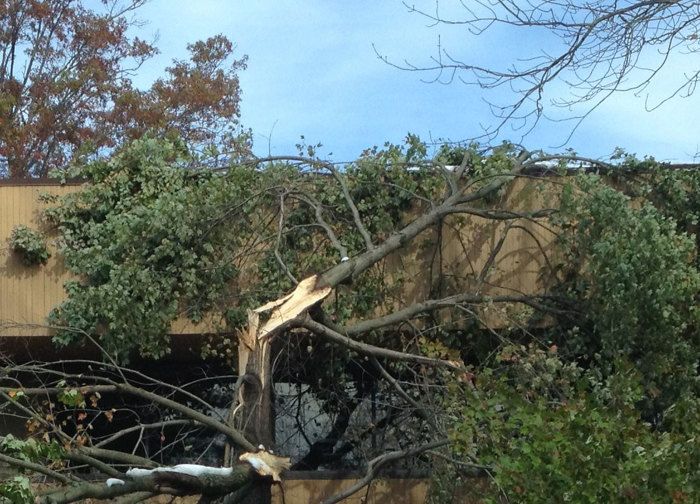
Storms have a habit of bringing out the worst in houses, turning little problems into bigger ones and sometimes reminding us of misguided shortcuts someone took in the past.
For New Englanders, this fall has been especially challenging, first with Hurricane Irene in late August and then a freak (and record-setting) snowstorm just two months later. Other parts of the country have had their own share of weather misery.
High wind, snow, hail, and driving rain all pose their own challenges, and prompt their own kinds of repairs.
FineHomebuilding.com has many articles on replacing or repairing the house parts that get damaged in storms, but if you have specific questions about the work you’re doing to you house, you might want to post a question in Fine Homebuilding’s Breaktime forum.
Here’s a compilation of relate topics that have popped up in the Breaktime forum:
Riders on the Storm
Storm induced roof damage is common. In drh’s case it was a hailstorm that blew through, and now he’s looking to replace the entire roof. There’s no shortage of salesman to talk with, drh says. They’ve been “all over our neighborhood after the storm.”
Drh would like to collect his insurance directly and pay the roofer himself, but the contractors he’s talked with don’t seem interested.
Is he being a pain in the neck?
A roofing contractor may work a better deal with the insurance company than the homeowner, writes DanH, because they’re used to dealing with claims. But watch who you’re doing business with.
“On the one hand, after a storm you’ll get a lot of fly-by-night roofers prowling around,” he writes. “One thing for sure: Don’t deal with anyone that isn’t reasonably local.”
The warning rings a bell with more than a few others.
“Not only will the storm chasers set up a local office/phone number, they’ll often buy out a small but long standing local roofing company,” says seeyou. “Look at their license plates. If the plates are from out of state, guess what? If they have a salesman that looks like he’s never banged a shingle on in his life, they’re probably storm chasers. If they suddenly have TV ads (especially if there are hot chicks in them), they’re probably storm chasers. If they have big chrome wheels on really pretty pickup trucks, they’re probably storm chasers.”
Davidmeiland suggests waiting a bit and hiring a company known for quality work after the fly-by-nights have packed up and left town. “Is your roof leaking, or will it last a few months?” Meiland asks. “Once the freaks that Grant is talking about are gone, hit the phones and find the A-list guys in your market.”
As to who handles the insurance, Sam thinks drh is on the right track:
“I would recommend letting the roofing company handle their own work and having you handle the insurance claim,” he writes. “When they find out how much money they are getting for the job they can keep most of it and do a poor job. Ask around your network for roofing companies who have done previous work.”
Repairing a broken rafter
Rodman’s 40-year-old Cape has a broken roof rafter. It’s apparently developed a 3-ft. long diagonal split starting at the bird’s mouth, resulting in a sag in the sheathing.
Can he make the repair by sandwiching the crack between two strips of 3/4-in. plywood, glued and screwed in place? Or is there a better way?
“How horrible would it be to sister a new full rafter to your busted one?” writes dieselpig. “That would be my first choice.”
And, as it turns out, the first choice of everyone else who responded.
“Or,” adds seeyou, “he could do like a jackass I used to work with wanted to do: Pour a concrete pier in the basement, install a lally column from the pier to the first floor, install another lally to the second floor, and jack from there to the rafter (this was a valley rafter under a slate roof) to push the sister and a flitch plate in place.
“I jacked it up and sistered it while he was drawing all that crap up.”
New roof gone bad
Dick Russell writes about the replacement of a hail-damaged roof on his brother’s Colorado house. Roofers removed several vents and replaced them with a continuous ridge vent. Where the vents were removed, contractors nailed sheet-metal patches over the holes in the sheathing.
At the same time, roofers didn’t cut back enough sheathing at the ridge for the new vent.
A call to the contractor brings a promise the ridge vent will be made right. And the metal matches are probably going to be just fine, see you tells Russell.
Still, Russell’s brother is miffed about the lack of adequate on-site supervision that would have resulted in a good job the first time around.
And it prompts this story from BilljustBill:
“In the mid ‘80’s had a roofer bid with #30 felt. When the supplies arrived there were #15 rolls of felt, not the #30. I called and they came out and replaced them with the #30 rolls. When they started a few days later, I was at work.
“In 1993, when a hail storm did in that roof, I wanted to be sure the insurance adjuster added enough to have the #30 put back. He took me around several places on my roof and pointed out that the roofer actually switched out the heavy felt and put down #15 anyway….
“The only way I’ve learned, the hard way, is to not pay the roofer a penny until all the roof is completed and approved….period. No matter what they promise, how much they say they’ll be back to fix things, it’s the power of the UNPAID dollar that gets it done right…”
Repairing broken window
John is planning on using vinyl windows with integral mounting tabs. Should someone heave a rock through the window (or a storm puts a branch through it), does the whole window have to come out, or can the sash alone be replaced?
It’s the sash that gets repaired, Jim says. After it’s removed, the frame is cut, the glass replaced and the sash welded back together with heat or cement. It’s a very common fix, he adds.
“It depends on what style of window but generally we just replace the sash when possible,” adds Matt. “A sash costs about $40 depending on size, etc. If it is a fixed pane like the top of a single hung we have the window company or glass company come out replace the glass. I’ve done it before myself, but it is a real PITA to get the old glass out.
“Having the glass replaced is more expensive than simply replacing the sash, by the time you pay for the labor for them to come out.”
Dan H agrees.
“In most cases they can be disassembled for glass replacement,” he writes, “but, given that most of the cost is in the glass itself, the sash replacement is often cheaper than the glass & labor for glass replacement.
Of course, finding a sash replacement for a 25-year-old window may be a challenge. Andersen is pretty good about it, but other manufacturers may not be.”
The flashing that wasn’t
Flashing diverts water safely away from penetrations in walls and roofs—as long as it’s installed correctly, or installed at all. That’s not always the case.
“What is it with siding contractors not flashing,?” asks richchem. “I haven’t seen a home close to right yet!
“Before I get assaulted, let me say I’ve looked at new homes, old homes, and homes built by builders and friends (I worked once in the industry). High end or low end. Nobody flashes properly around windows and doors with vinyl siding.”
Andybuildz is careful to make his own drip cap, but he thinks part of the problem is that siding contractors have tunnel vision. “They just wanna BANG UP SQUARES,” he says, “where the thinking is ‘can’t see it from my house.’”
John Sprung owns a stucco house built in 1926. No flashing whatsoever. And Geob21 adds this: “On track built and semi custom homes in Maryland the norm is nailing siding directly to OSB sheathing. So the real question is what good would the flashing do even if it was installed?”
To TommyB12, installing flashing properly is “arguably the most overlooked of essential building practices,” yet he’s never had a customer ask him about flashing details on a siding project.
He describes a house with a decorative skirt board that wasn’t flashed at all.
“It was a detail throughout the whole house,” he writes. “Worse yet, the house is sheathed in that exterior gypsum product. Basically the house was destroyed. No plywood on the whole building, no metal t=bracing. No shear panels whatsoever. There were a hundred or so houses in that development alone, all the same. Probably thousands in the area, god only knows how many throughout the country…A few bucks in flashings would have prevented thousands of dollars in repairs.”
Fine Homebuilding Recommended Products
Fine Homebuilding receives a commission for items purchased through links on this site, including Amazon Associates and other affiliate advertising programs.

Affordable IR Camera

Reliable Crimp Connectors

Handy Heat Gun



















